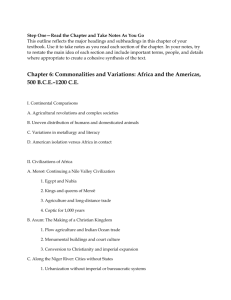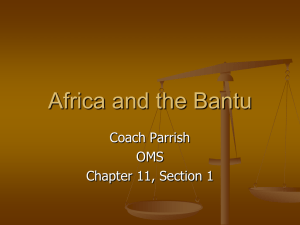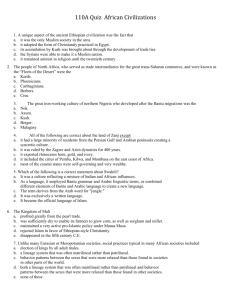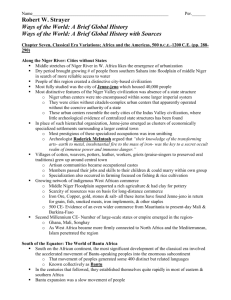History of West African People: The Bantu
advertisement
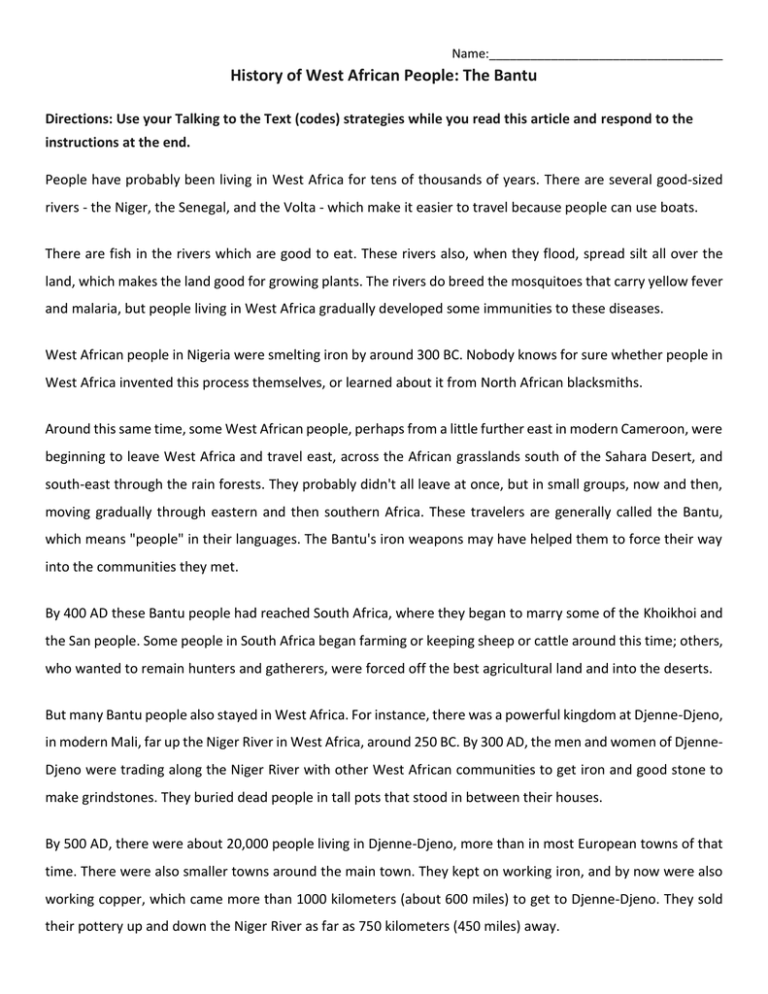
Name:__________________________________ History of West African People: The Bantu Directions: Use your Talking to the Text (codes) strategies while you read this article and respond to the instructions at the end. People have probably been living in West Africa for tens of thousands of years. There are several good-sized rivers - the Niger, the Senegal, and the Volta - which make it easier to travel because people can use boats. There are fish in the rivers which are good to eat. These rivers also, when they flood, spread silt all over the land, which makes the land good for growing plants. The rivers do breed the mosquitoes that carry yellow fever and malaria, but people living in West Africa gradually developed some immunities to these diseases. West African people in Nigeria were smelting iron by around 300 BC. Nobody knows for sure whether people in West Africa invented this process themselves, or learned about it from North African blacksmiths. Around this same time, some West African people, perhaps from a little further east in modern Cameroon, were beginning to leave West Africa and travel east, across the African grasslands south of the Sahara Desert, and south-east through the rain forests. They probably didn't all leave at once, but in small groups, now and then, moving gradually through eastern and then southern Africa. These travelers are generally called the Bantu, which means "people" in their languages. The Bantu's iron weapons may have helped them to force their way into the communities they met. By 400 AD these Bantu people had reached South Africa, where they began to marry some of the Khoikhoi and the San people. Some people in South Africa began farming or keeping sheep or cattle around this time; others, who wanted to remain hunters and gatherers, were forced off the best agricultural land and into the deserts. But many Bantu people also stayed in West Africa. For instance, there was a powerful kingdom at Djenne-Djeno, in modern Mali, far up the Niger River in West Africa, around 250 BC. By 300 AD, the men and women of DjenneDjeno were trading along the Niger River with other West African communities to get iron and good stone to make grindstones. They buried dead people in tall pots that stood in between their houses. By 500 AD, there were about 20,000 people living in Djenne-Djeno, more than in most European towns of that time. There were also smaller towns around the main town. They kept on working iron, and by now were also working copper, which came more than 1000 kilometers (about 600 miles) to get to Djenne-Djeno. They sold their pottery up and down the Niger River as far as 750 kilometers (450 miles) away. Name:__________________________________ Instructions: Use the reading to draw the migrations of the Bantu People. Include any countries, geographic features, or vegetation zones mentioned in the article. You will likely need a map or Internet as a resource. Name:__________________________________ The Story of Africa: Early History PEOPLE ON THE MOVE Armed with iron smelting technology the Bantu of west and central Africa dispersed across the continent, changing its linguistic and cultural landscape. A number of theories have been put forward to explain this migration. "When people move they move for a reason. They move because the population has expanded. They move because the resources which support the population in the settlements have become more or less inadequate. They move because there are changes to the climate and they move for the sake of finding better areas in which to live." - Professor Leonard Ngcongco, University of Botswana. SLOW BUT STEADY One theory is that there were waves of migration, one moving through the east of Africa and another making its way through the center of the continent. In Zambia, there is evidence of at least three routes of migration from the great lakes, from the Congo forest and from Angola. There is evidence that the Bantu ancestors of the modern Swahili peoples mastered sailing technology and possessed canoes and boats so they could make their way along the Zambezi River. "Chief among the reasons for migration is environmental stress and population increase in West Africa, forcing people to move. It is important to realize that these people are not moving across the landscape like Bugs Bunny or the Energizer bunny, but essentially they are moving slowly, gradually inhabiting areas that were good for farming and livestock raising." - Dr Chapirukha Kusimba, Field Museum, Chicago CONQUERORS, COLONIZERS OR ADVENTURERS? Most historians appear to believe that rather than arriving en masse like a conquering horde, the migrations were more sporadic with small pockets of people moving from one point to another. It is not entirely clear how the Bantu reacted when they came upon existing communities but it is likely that there was considerable absorption, assimilation and displacement of other peoples during the migration period. The Bantu were armed with superior weapons and their iron implements allowed them to cultivate land and clear forests efficiently. If they came as colonizers, then it is unlikely to be in the sense we understand the term today. Historians believe there was social interaction and intermarrying and trade. Name:__________________________________ EVIDENCE The evidence for migration is based on three main areas of research. They are: Linguistic A comparative study of languages spoken in some parts of eastern, central and southern Africa show similarities with the mother tongues originally spoken in West Africa. There are some 450 known languages in the Bantu family from Gikuyu in the north to Setswana in the south. Pottery There is evidence of similar pottery technology in eastern, southern and western Africa. Iron Age farmers were skilled pot makers and decorated their pots with grooves and patterns. Related groups of peoples used similar styles of decoration. Iron There is little or no evidence of iron working in east and southern Africa before the arrival of the Bantu suggesting that new technology was spread by the migrants. The Bantu proved enormously successful at adapting to their new environments and it has been argued by some historians that they brought not only new methods of survival but the development of the system of statehood that we still find today. "In some areas they brought notions of government, controlling people, development of leadership, chieftaincy, state-craft and organizing people for campaigns for battles and also maybe a kind of advanced religion." - Professor Leonard Ngcongco But as with most areas of early African history there is a note of caution to be sounded when discussing the Bantu migration. There is even an argument for saying that it did not happen at all. DID IT HAPPEN? "The question concerning whether or not the Bantu migration actually occurred will await further research. It's very easy to assume that we know so much. Actually we know so little because very little research has been done. So far there is a huge area in DR Congo, Rwanda and Uganda where no field work has been done and these are areas that the Bantu peoples would have passed through." - Dr Chapirukha Kusimba, Field Museum, Chicago http://www.historyforkids.org/learn/africa/history/bantu.htm http://www.bbc.co.uk/worldservice/africa/features/storyofafrica/2chapter5.shtml Name:__________________________________ Instructions: Use The Story of Africa: Early History to respond to the following prompts. 1. Provide evidence that, “when people move, they move for a reason.” a. b. c. d. e. f. 2. The Bantu likely could have been conquerors, but scientists believe they assimilated instead. Provide evidence for both theories: conquerors and assimilators. a. b. Name:__________________________________ 3. If you were a scientist or historian studying the migration of Bantu people across Africa, provide specific examples of what you might find to help prove the Bantu had been in a particular region. a. b. c. 4. Kusimbas states that, “we know so little because very little research has been done.” Use a map and the Internet to look at the regions mentioned by Kusimbas. Why you do believe so little research has been done in these areas. Use your knowledge of geography to help you provide a reason; write in complete sentences. a.

